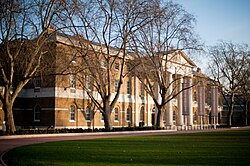Duke of York's Headquarters
| Duke of York's Headquarters | |
|---|---|
| Chelsea, London | |

The Duke of York's Headquarters in December 2009
|
|
|
Location within London
|
|
| Coordinates | 51°29′26″N 0°09′32″W / 51.4906°N 0.1589°WCoordinates: 51°29′26″N 0°09′32″W / 51.4906°N 0.1589°W |
| Type | Drill Hall |
| Site history | |
| Built | 1801 |
| Built for | War Office |
| Architect | John Sanders |
| In use | 1801-Present |
The Duke of York's Headquarters is a building in Chelsea in the Royal Borough of Kensington and Chelsea, England. In 1969 it was declared a listed building at Grade II*, due to its outstanding historic or architectural special interest.
The building was completed in 1801 to the designs of John Sanders, who also designed the Royal Military Academy Sandhurst. It was originally called the Royal Military Asylum and was a school for the children of soldiers' widows. In 1892 it was renamed the Duke of York's Royal Military School. In 1909, the school moved to new premises in Dover, and the Asylum building was taken over by the Territorial Army and renamed the Duke of York's Barracks in 1911. During the First World War it was the headquarters of the 18th (County of London) Battalion, London Regiment (London Irish Rifles) and of the Middlesex Yeomanry.
During the Second World War, the courts martial of German spies, Josef Jakobs and Theodore Schurch, (both tried under the Treachery Act 1940) were both conducted in the building.
In 1980 the building was extensively restored and renovated, with the £1.5 million programme being carried out by Donald Insall Associates. At that time the building served as the Headquarters for the Territorial Army in Greater London, and as the home of Territorial units 144 Parachute Field Ambulance RAMC(V), 257 (Southern) General Hospital RAMC, 21 Special Air Service Regiment (Artists), and companies of the TA Parachute Regiment and the London Irish Rifles. In addition, it served as the headquarters of the Royal Corps of Signals and First Aid Nursing Yeomanry, and as the home of the Coldstream Guards Band, and a Light Aid Detachment of the Royal Electrical and Mechanical Engineers. It also housed the offices of the RAF Escaping Society, the Army Historical Association, the Army Benevolent Fund, and the Soldiers, Sailors and Airmen's Families Association.
...
Wikipedia

